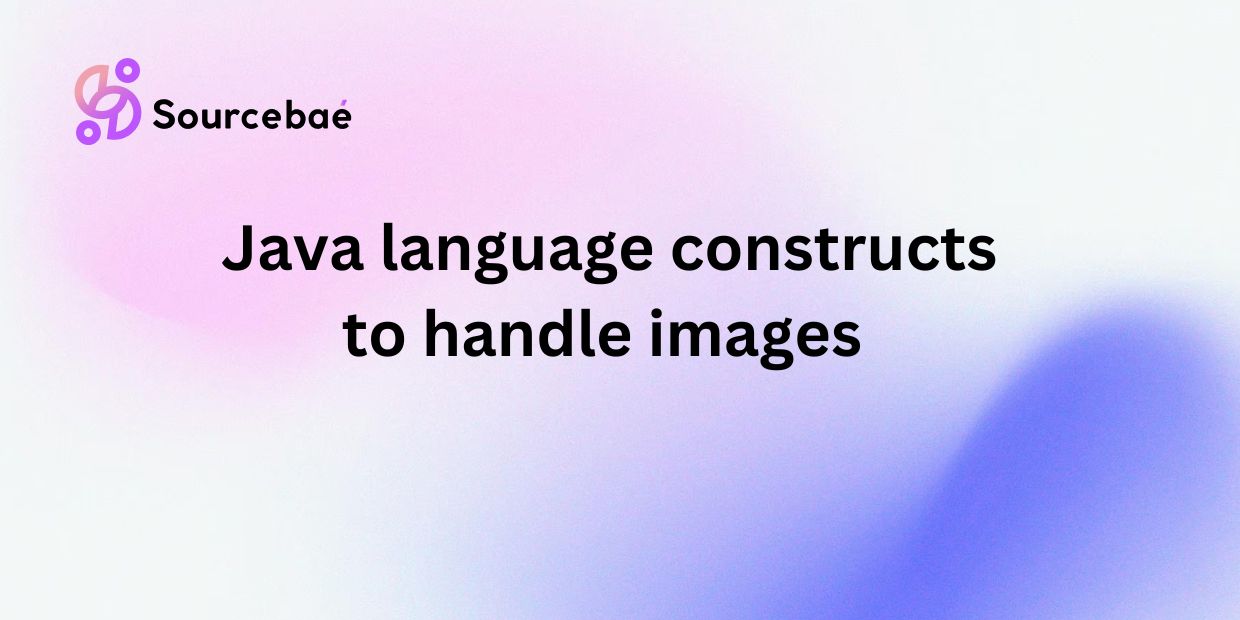Java is one of the most widely used programming languages in the world, known for its versatility and robustness. It is commonly used for developing various types of applications, including web, desktop, and mobile applications. One important aspect of Java programming is handling images in Java applications. In this blog post, we will explore the importance of Java language constructs to handle images, as well as key language constructs for image processing in Java.
Introduction
Brief Overview of the Java Programming Language
Java is a high-level, object-oriented programming language developed by Sun Microsystems in the early 1990s. It is platform-independent, which means that Java programs can run on any system that has a Java Runtime Environment (JRE) installed. Java is known for its “write once, run anywhere” philosophy, making it a popular choice for developing cross-platform applications.
Importance of Handling Images in Java Applications
Images are a common component of many applications, whether it be for displaying pictures, icons, or graphics. In Java applications, handling images is essential for creating visually appealing user interfaces and providing a better user experience. By understanding how to work with images in Java, developers can enhance the functionality and aesthetics of their applications.
Key Language Constructs for Image Processing in Java
Java provides several classes and libraries for working with images, making it easier for developers to manipulate, process, and display images in their applications. Some key language constructs for image processing in Java include ImageIO for loading and saving images, BufferedImage for manipulating images, and GUI components for displaying images on graphical user interfaces.
Java Image Handling Basics
Loading Images Using ImageIO
ImageIO is a class in Java that provides methods for reading and writing images in different formats, such as PNG, JPEG, and GIF. By using ImageIO, developers can easily load images from files or streams into their Java applications.
When working with ImageIO, developers can use the `ImageIO.read()` method to read an image file and convert it into a `BufferedImage` object, which can then be used for further processing or displaying.
Displaying Images on GUI Applications
Java provides several classes for creating graphical user interfaces (GUIs), such as JFrame, JPanel, and JLabel, which can be used to display images in Java applications. By adding an `ImageIcon` to a `JLabel` component, developers can easily display images on GUIs and customize the appearance based on their requirements.
Manipulating Images Using BufferedImage
BufferedImage is a class in Java that represents images as a two-dimensional array of pixels. By using BufferedImage, developers can perform various image manipulation tasks, such as scaling, rotating, and applying filters.
Developers can create a BufferedImage object from an existing image using the `ImageIO.read()` method, and then use methods such as `getRGB()` and `setRGB()` to manipulate individual pixels in the image.
Saving Images to File Using ImageIO
After processing or manipulating an image in Java, developers can save the resulting image to a file using ImageIO. By using the `ImageIO.write()` method, developers can specify the format and location where the image should be saved.
Advanced Java Image Processing Techniques
Resizing and Cropping Images
Resizing and cropping images are common tasks in image processing, and Java provides built-in methods for accomplishing these tasks. Developers can use methods in the `AffineTransform` class to scale or resize images, as well as methods in the `BufferedImage` class to crop images to a specific size or aspect ratio.
Applying Filters and Transformations
Java also provides a range of image filters and transformations that developers can apply to images to enhance their appearance or achieve specific effects. By using classes such as `RescaleOp` for adjusting brightness and contrast, or `ConvolveOp` for applying convolution filters, developers can modify images in various ways.
Converting Images Between Different Formats
In addition to loading and saving images in different formats, Java also allows developers to convert images between different formats. Developers can use methods in the `ImageIO` class to convert images to formats such as JPEG, PNG, or GIF, depending on their requirements.
Performing Image Analysis and Recognition
For more advanced image processing tasks, developers can use libraries such as OpenCV or Java Advanced Imaging (JAI) to perform image analysis and recognition. These libraries provide functions for detecting objects, recognizing patterns, and extracting features from images, making them useful for applications such as image classification or computer vision.
FAQs
How Do I Handle Image Transparency in Java?
In Java, developers can handle image transparency by using images with an alpha channel, which specifies the opacity of each pixel in the image. By creating images with transparency information, developers can achieve effects such as blending layers or creating translucent objects in their applications.
What Are the Performance Considerations When Processing Images in Java?
When processing images in Java, developers should be mindful of performance considerations such as memory usage, CPU usage, and processing time. To optimize performance, developers can use techniques such as caching images, reducing the size of images before processing, and utilizing multithreading for parallel processing.
How Can I Optimize Memory Usage When Working With Large Images?
Working with large images in Java can consume a significant amount of memory, which can lead to performance issues or memory leaks. To optimize memory usage, developers can use techniques such as loading images incrementally, freeing up memory after processing, or using data structures that are more memory-efficient.
Are There Any Libraries or Frameworks That Can Simplify Image Processing in Java?
Yes, there are several libraries and frameworks available for simplifying image processing in Java, such as Apache Commons Imaging, Marvin Framework, and JavaFX. These libraries provide pre-built functions and classes for common image processing tasks, making it easier for developers to work with images in their Java applications.
What Are the Best Practices for Handling Images in Multi-Threaded Java Applications?
When handling images in multi-threaded Java applications, developers should be careful to ensure thread safety and avoid race conditions when accessing shared resources. Developers can use techniques such as synchronization, locks, or concurrent data structures to prevent conflicts between threads and ensure that image processing is performed correctly.
Conclusion
Recap of Key Java Language Constructs for Image Processing
In this blog post, we have explored some key language constructs and techniques for handling images in Java applications, including loading images with ImageIO, manipulating images with BufferedImage, and displaying images on GUI applications. By understanding these constructs, developers can enhance their image processing capabilities and create more dynamic and interactive applications.
Importance of Understanding Image Handling Techniques in Java
Image handling is an essential aspect of Java programming, particularly for applications that require visual elements or graphical content. By mastering image handling techniques in Java, developers can create more engaging and professional-looking applications that meet the needs of their users.
Resources for Further Learning and Exploration
For those interested in diving deeper into image processing in Java, there are plenty of resources available online, including tutorials, documentation, and libraries. By exploring these resources and experimenting with different techniques, developers can expand their skills and discover new ways to leverage images in their Java applications.
In conclusion, Java language constructs to handle images is a valuable skill for developers looking to create visually appealing and interactive applications. By understanding the basics of image processing in Java and exploring advanced techniques, developers can enhance their programming abilities and deliver high-quality applications that make an impact.
If you’re a developer aiming to join top tech companies, Sourcebae is here to help. Create your profile, share your details, and let us take care of the rest!





